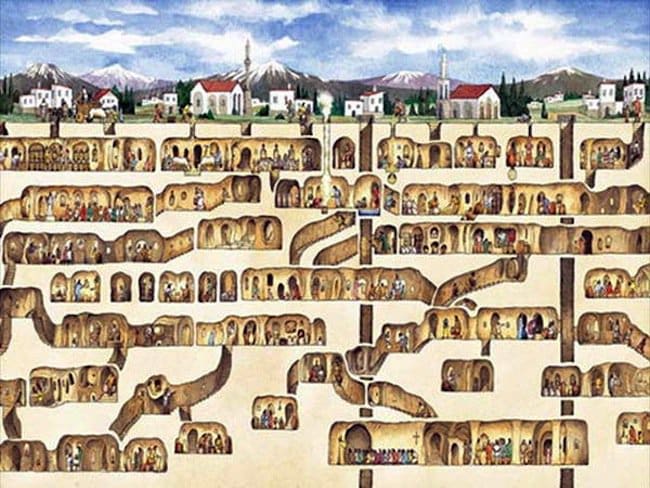That’s the story that happened in 1963, when a man in Turkey carried out repairs to his house in the town of Derinkuyu, Nevşehir province in the Cappadocia region. A very strange thing happened that during the renovation of the house, his chickens disappeared one after another without being found, which excluded the case that they lost their way to the neighbor’s house.

Then, he discovered a hole and long cracks in the basement of the house and confirmed the chickens had gone through it without finding a way out.
The man decided to knock down the basement wall to rescue the chickens. Unexpectedly, it led him to an unexpected discovery, causing archaeologists to flock to research.
It turned out that behind that wall was an entire city from ancient times with a capacity of up to 20,000 people. It is called the underground city of Derinkuyu.

This ancient city has existed for thousands of years.
The excavation process has taken archaeologists from one surprise to another. Because this city is a network of tunnels and shelters up to 18 floors, 85 meters deep, can house 20,000 people and their livestock.
Back in history
Since prehistoric times, the area of Cappadocia has been covered with a layer of tuff rock, a rock formed from volcanic ash about 20 million years ago. This rock layer is eroded by water currents, creating rock caves. Seeing that this stone is soft, it is quite easy to cut and process, so the Hittites (ancient Anatolians) carved tunnels.
Over time, this burrowing activity created living complexes, including monasteries, that eventually became an underground city.
The top of the house is like the mouth of a well, the bottom is wide open, there is an entrance for livestock, and people go down to the house by ladder. The whole family lives in the house with goats, sheep and cattle.
Some experts believe that the underground city of Derinkuyu may have been built between 780-1180 BC. It has enough kitchens, stables, churches, tombs, wells, common rooms, schools and even huge bunkers to prevent natural disasters.

In this ancient city, scientists also discovered churches and inscriptions from the Greek era. About 600 doors were built to connect the areas. Each floor has its own shortcut to hide when in danger. In addition, Derinkuyu also has very heavy stone doors with wheels that are closed inside to prevent strangers from entering.

In later centuries, it appears that the Christian inhabitants of the Roman Empire expanded the cave system by adding more layers and including chapels, stables, wineries, and olive oil production. Liu.
It was also used by Christians of the Byzantine Empire for shelter from bandits, and it was during this time that the underground city of Derinkuyu was said to be the most crowded.

After the fall of the Byzantines, the local Christian community used this underground city to hide from Ottoman oppression for a few more centuries.
Although the city may be thousands of years old, it was only hidden for about 40 years when Christians in Anatolia were forced out of their homes and taken to Greece in a raid. population exchange in 1923.
Amazing calculations
In 18 floors of the city, researchers found kitchens, bedrooms, bathrooms, pantry, oil and wine presses, wells, weapons storage areas, churches, schools, tombs and barn.
There are different sized rooms for different needs. Small spaces become stone-cut tombs, while large spaces provide large rooms for community and school meetings.

Cattle room.
It seems the ancients had perfectly planned a self-sufficient, impregnable underground life. They have calculated very carefully to ensure the most comfortable life possible. For example, they made more than 50 ventilation shafts that bring air down from above, while thousands of smaller ducts distribute the air throughout the city. This ensures all residents have air to breathe.
Cattle were also brought down which meant that people still had enough to eat even when an external threat prevented them from getting out. Animals are kept on floors closer to the ground to avoid odors from their droppings. Meanwhile, the warehouses can hold enough food for them to stay underground for a whole month.

Ventilation shaft from top to bottom.
Derinkuyu also helps residents avoid extreme hot weather in summer and too cold, snowfall in winter. The temperature stays constant year-round, around 13 degrees Celsius, creating a cool environment for the animals, while maintaining a supply of fresh water and keeping food fresh.